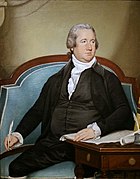19 포르투나
19 Fortuna | |
| 디스커버리 | |
|---|---|
| 검색 대상 | 존 러셀 힌드 |
| 발견일자 | 1852년 8월 22일 |
| 지정 | |
| (19) 포르투나 | |
| 발음 | /fɔːrˈtjuːnə/[1] |
이름을 따서 명명됨 | 포르투나 |
| A902 UG | |
| 메인 벨트 | |
| 형용사 | Fortunian /fɔrrjuniəni/n/ |
| 궤도 특성[2] | |
| 에폭, 2004년 10월 22일 (JD 2453300.5) | |
| 압헬리온 | 2.831AU(423.443gm) |
| 페리헬리온 | 2.052AU(307.028gm) |
| 2.441 AU(365.235gm) | |
| 편심성 | 0.159 |
| 3.81 a(1393.378 d) | |
평균 궤도 속도 | 18.94km/s |
| 268.398° | |
| 기울기 | 1.573° |
| 211.379° | |
| 182.091° | |
| 물리적 특성 | |
| 치수 | c/a = 0.79±0.05[3] (225×205×195)±12km[4] |
평균 지름 | 211±2km[3] 225km[5][6] |
| 미사 | (8.8±1.4)×10kg18[3] 12.7×1018 kg[4] |
평균 밀도 | 1.80±0.29g/cm3[3] 2.70±0.48g/cm3[4] |
적도 표면 중력 | ~0.0629 m/s² |
| ~0.1190km/s | |
| 0.1551 d(7.4432 h)[2] | |
| 0.056[3]0.037[2] | |
| 온도 | ~180K |
| G[2] | |
| 8.88[7] ~ 12.95 | |
| 7.13[2] | |
| 0.25" ~ 0.072" | |
Fortuna(소행성 명칭: 19 Fortuna)는 가장 큰 주벨트 소행성 중 하나이다.그것은 1 세레스와 비슷한 구성을 가지고 있는데, 그것은 털린을 포함한 원시 유기 화합물의 구성으로 우주가 많이 깨져 있는 어두운 색상의 표면이다.
Fortuna는 지름이 225km이고 지름이 150km가 넘는 소행성으로 알려진 가장 어두운 기하학적 알베도 중 하나이다.그것의 알베도는 0.028과 0.037로 측정되었다.[8]소행성의 스펙트럼은 수성 변화의 증거를 보여준다.[9]
허블 우주 망원경은 1993년에 Fortuna를 관측했다.겉보기 지름 0.20아크초(행성카메라 4.5픽셀)로 해결됐고, 모양은 거의 구형인 것으로 확인됐다.인공위성이 수색되었지만 탐지된 것은 없었다.
Fortuna에 의한 별의 신비로운 발견은 여러 번 관찰되었다.Fortuna는 레이더에 의해 연구되어 왔다.[10]
1852년 8월 22일 J. R. 힌드에 의해 발견되었으며, 로마의 행운의 여신 포르투나의 이름을 따서 명명되었다.
Fortuna는 80km 135 Hertha에 의해 혼란에 빠졌고, 처음에 Baer에 의해 질량이 1.08×10kg으로19 추정되었다.[6]Baer에 의한 더 최근의 추정은 그것의 질량이 1.27×1019 kg이라는 것을 암시한다.[4]
2012년 12월 21일 포투나(약 200km)가 소행성 687 티넷의 6.5gm 내에서 무해하게 지나갔다.[11]
참조
- ^ 노아 웹스터 (1884) 영어실용사전
- ^ a b c d e "JPL Small-Body Database Browser: 19 Fortuna" (2008-08-21 last obs). Retrieved November 11, 2008.
- ^ a b c d e P. 버나자 외(2021) 최대 주벨트 소행성에 대한 VLT/Sphere 영상 조사:최종 결과 및 종합.천문 & 천체물리학 54, A56
- ^ a b c d Jim Baer (2008). "Recent Asteroid Mass Determinations". Personal Website. Archived from the original on October 21, 2013. Retrieved November 27, 2008.
- ^ Storrs, Alex; Weiss, B.; Zellner, B.; et al. (1998). "Imaging Observations of Asteroids with Hubble Space Telescope" (PDF). Icarus. 137 (2): 260–268. Bibcode:1999Icar..137..260S. doi:10.1006/icar.1999.6047. Archived from the original (PDF) on February 25, 2012. Retrieved January 15, 2005.
- ^ a b Baer, James; Steven R. Chesley (2008). "Astrometric masses of 21 asteroids, and an integrated asteroid ephemeris". Celestial Mechanics and Dynamical Astronomy. Springer Science+Business Media B.V. 2007. 100 (2008): 27–42. Bibcode:2008CeMDA.100...27B. doi:10.1007/s10569-007-9103-8.
- ^ "AstDys (19) Fortuna Ephemerides". Department of Mathematics, University of Pisa, Italy. Retrieved June 27, 2010.
- ^ Storrs, Alex; Dunne; Conan; Mugnier; et al. (2005). "A closer look at main belt asteroids 1: WF/PC images" (PDF). Icarus. 173 (2): 409–416. Bibcode:2005Icar..173..409S. doi:10.1016/j.icarus.2004.08.007. Archived from the original (PDF) on April 18, 2007. Retrieved September 23, 2007.
- ^ Fornasier, S.; et al. (February 1999), "Spectroscopic comparison of aqueous altered asteroids with CM2 carbonaceous chondrite meteorites", Astronomy and Astrophysics Supplement, 135: 65–73, Bibcode:1999A&AS..135...65F, doi:10.1051/aas:1999161.
- ^ "Radar-Detected Asteroids and Comets". NASA/JPL Asteroid Radar Research. Retrieved October 30, 2011.
- ^ Aldo Vitagliano에 의해 Wayback Machine에서 2008년 12월 20일 보관된 Solex 10으로 생성
외부 링크
- 19 Fortuna at AstDyS-2, 소행성—동적 사이트
- JPL 소체 데이터베이스에서의
 19 Fortuna
19 Fortuna


